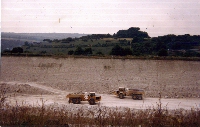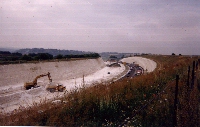Why we're still fighting to Save Stonehenge!
Last revised: 4 June 2003.
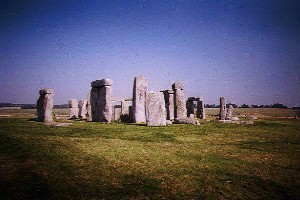
Picture by Ian Britton from FreeFoto.com
The British government is planning to build a new highway. Guess where! Right through the middle of one of the most famous heritage sites in the world: Stonehenge. They're not going to destroy the monument, but the road they plan to build will, nevertheless, carve a huge swathe of destruction through the protected area around the famous stones known as the Stonehenge World Heritage Site (WHS).
A little bit of history
How has this ludicrous plan come to pass? The British government can't really get away with building big new roads these days: people protest too much. But it's quite keen on widening existing roads, adding new bits here and there, and so building its new roads sneakily and "by stealth". For a long time, it has harboured a plan to build a massive new highway linking London and the south east of England with Corwall, Devon, and the south west. It planned to do this by widening the existing A303 road. Unfortunately, the A303 passes uncomfortably near to Stonehenge.
Not even the British government could get away with trashing Stonehenge, so they thought of a different idea. "Let's build a massive new road that will appear to offer some benefits to Stonehenge. That way people might be fooled into thinking it's a good idea. Let's get a few archaeologists on board for good measure. Let's pretend this is all for the benefit of Stonehenge."
This is exactly what they did. They called their idea the Stonehenge Master Plan. It was going to involve an improved visitors' centre for the site, better access to the stones, and, of course, four lanes of nice thick tarmac right through the middle of the World Heritage Site. That's not quite true. Actually, the middle bit of the road was going to be put in a tunnel. Not a proper tunnel, you understand, but a dirty great bulldozed scar with a little roof added on top afterward for good measure (a brutal construction technique known as "cut-and-cover'). In one place, the construction zone for the new road was going to be over ten times wider than the existing road.
The British government and its roadbuilding wing, the Highways Agency, successfully persuaded quite a lot of people that the Stonehenge Master Plan was a good idea. Those people included one of Britain's most influential environmental and heritage charities, the National Trust (not connected with the US National Trust) and English Heritage (another British government offshoot supposed to be responsible for the care and protection of archaeology and heritage). English Heritage liked the scheme so much that they offered to help fund it.
But not surprisingly, a lot of people didn't think much of the Stonehenge Master Plan. They saw straight through it: it was a trojan horse -- another massive, highly destructive, totally unnecessary highway with a few grass seeds sprinkled on top so it didn't seem quite so bad. English Heritage couldn't understand what all the fuss was about. As their chief archaeologist, Dr Geoffrey Wainwright, said: "It is total nonsense to say a great deal of archaeological damage will be done. The tunnel is for the greater good. You have to compromise."[1]
But too many people had already worked out that the Master Plan was a bad idea. The scheme was slowly starting to unravel. Eventually, even the National Trust changed its mind. After studying the new plans, it came to the conclusion that a much longer tunnel was needed. And it said so. At this point, the Stonehenge Master Plan fell apart completely. The National Trust owns most of the land around Stonehenge and, without its support, nothing can be done there. That's why, in December 2002, the British government had a change of heart.
Well almost.
It agreed to spend an extra £30 million on the highway scheme so that the middle part of the new road -- the tunnel section -- could be built in a less destructive way. Instead of being blasted through the site with bulldozers, it would now be bored underneath, sparing some of the surface archaeology. Suddenly, archaeologists who had supported the original scheme now admitted it perhaps wasn't such a good idea after all. Dr Geoffrey Wainwright was one of them: "This is a much better deal than the cut and cover tunnel - the thought of gouging that massive trench across such a precious landscape just brought tears to my eyes." [2]
The Stonehenge Master Plan was promptly reborn The Stonehenge Project. The latest map of the scheme is shown below. You can get more details from the Stonehenge Project website.
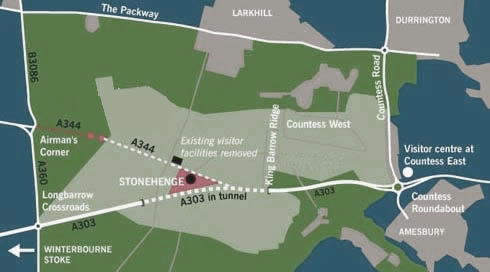
Why we still oppose the plan
So the new tunnel is great and everything's going to be OK and all's well with the world? Not exactly. Not even close. The new tunnel is almost as bad as the old one. Here's why Save Stonehenge is still objecting to the British government's plans for Stonehenge:
Second best scheme
It is a "make do", "second-best" scheme that prioritizes the presumed (and unproven) need to build a new highway over the interests of Stonehenge. It presupposes that saving a few minutes of time for a few motorists is more important than saving 5000 years of history.
Tunnel is too short
The tunnel is far too short. According to ICOMOS-UK, the group of British archaeologists whose job it is to safeguard the Stonehenge site, "We do not support [a 2.1 km tunnel] because the shorter length fails to deliver in our view substantial enough cultural and social benefits."
It's still a cutting!
Apart from the central 2.1 km section, the new highway will still be a surface road and most of it will still be bulldozed through the World Heritage Site. Outside the tunnel, two thirds of the WHS would be permanently divided by a noisy and unsightly four-lane highway, securely fenced and with long cuttings leading down to the tunnel entrances, lit day and night.
It'll trash other places too
The road would still have major ecological impacts (in particular, damaging impacts on the Till and Avon rivers, both strictly protected by European environmental law).
It ignores the World Heritage Convention
Under Article 4 of the World Heritage Convention, which protects Stonehenge, the British government pledged to ensure the "protection, conservation, presentation and transmission to future generations "of its World Heritage Sites, doing "all it can to that end, to the utmost of its own resources and, where appropriate, with any international assistance and cooperation, in particular, financial, artistic, scientific and technical, which it may be able to obtain".
With its current plans, the British government is bulldozing not just
through the World Heritage Site but through the World Heritage Convention
as well.
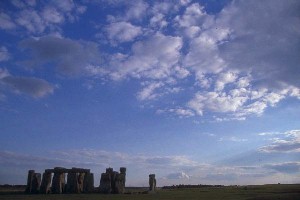
Picture by Ian Britton from FreeFoto.com
Roadbuilding does not solve transport problems
A new highway would generate extra traffic instead of solving congestion. It is not consistent with the British government's long-stated aims to reduce dependence on car travel. Major roadbuilding is completely inconsistent with international commitments to reduce carbon-dioxide emissions from road transport.
It will ruin the ancient landscape, not restore it
Supporters of this scheme talk about "reuniting Stonehenge with its prehistoric landscape". Nothing could be further from the truth. Bulldozers will still carve deep cuttings through the World Heritage Site, parts of which will be substantially remodelled. Perhaps the archaeologists who have lent their name to support the new scheme have never witnessed what happens when the British government builds a road?
Here are some photos to give you a taste of what motorway construction in the Stonehenge World Heritage Site could look like. They were taken during the construction of the notorious M3 cutting through Twyford Down, near Winchester, which obliterated a Bronze-Age village. Scarily enough, that highway was designed and engineered by Mott Macdonald, the company who won the contract to help design the Stonehenge scheme in February 2001.
Coming soon to a World Heritage Site near you?
Pictures of motorway construction at Twyford Down, Summer 1994.
Click the small photos to see bigger ones (about 200K JPG files).
So what are the alternatives?
Many and varied. The British government and its Highways Agency would have us believe all the alternatives have already been "exhaustively explored" and rejected. Nothing could be further from the truth. What they mean is: this is the highway they want and this is the highway they are determined to build.
We say: does it matter if it takes ten years, twenty years, or fifty years to sort out Stonehenge? We should do the right thing, not the quickest thing. Stonehenge has been there for 5000 years; why ruin it in five minutes?
For more detail about a number of different plans that have been proposed, take a look at our alternatives page.
The wrong solution
As for the present plan, no-one puts it better than Lord Kennet, Chairman of the Stonehenge Alliance:"The greatest disgrace is the wrong solution. No other country in the world would contemplate treating a site which is a world icon in such a way."[3].
We hope you agree with us
And if you do, we need your help. With other opponents of the scheme, we scored a major victory by knocking out the cut-and-cover tunnel.Now we need to fight for the right scheme at Stonehenge.
You can help us Save Stonehenge
One of the best things you can do to help is to sign up for our occasional action email list. Every few months or so, we'll send you an email with the latest news and suggestions for positive things you can do to help our campaign.
Thanks so much for your support!
References[1] Quoted in BBC News Online, 22 September 1998:
[2] Quoted in The Guardian, 11 December 2002.
[3] Quoted in The Guardian, 19 August 1998.

